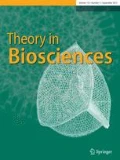Abstract
Detailed analyses into the life cycle of the soil-dwelling microbe Dictyostelium discoideum led to the conclusion that this “social amoeba” practices some form of “non-monoculture farming” via the transfer of bacteria to novel environments. Herein, we show that in myxomycetes (plasmodial slime molds or myxogastrids) a similar “farming symbiosis” has evolved. Based on laboratory studies of two representative species in the genera Fuligo and Didymium, the sexual life cycle of these enigmatic microbes that feed on bacteria was reconstructed, with reference to plasmo- and karyogamy. We document that the spores carry and transfer bacteria and hence may inoculate new habitats. The significance of this finding with respect to Ernst Haeckel’s work on myxomycetes and his concept of ecology are addressed.
Similar content being viewed by others
References
Bodini A, Klotz S (2018) The science of ecology for a sustainable world. Ecology 1:1–33
Boomsma JJ (2011) Evolutionary biology: farming writ small. Nature 469:308–309
Brock DA, Douglas TE, Queller DC, Strassmann JE (2011) Primitive agriculture in a social amoeba. Nature 469:393–396
Brock DA, Read S, Bozhchenko A, Queller DC, Strassmann JE (2013) Social amobea farmers carry defensive symbionts to protect and privatize their crops. Nat Commun 4(2385):1–7
Clark J, Haskins EF (2013) The nuclear reproductive cycle in the myxomycetes: a review. Mycosphere 4:233–244
Dahl MB, Brejnrod AD, Unterseher M, Hoppe T, Feng Y, Novozhilov Y, Sørensen SJ, Schnittler M (2017) Genetic barcoding of dark-spored myxomycetes (Amoebozoa)—identification, evaluation and application of a sequence similarity threshold for species differentiation in NGS studies. Mol Ecol Resource 18:306–318
De Bary A (1859) Die Mycetozoen (Schleimpilze). Ein Beitrag zur Kenntnis der niedersten Organismen. Wilhelm Engelmann, Leipzig
Gilbert SF (2006) Developmental biology, 8th edn. Sinauer Associates, Sunderland
Hadjivasiliou Z, Pomiankowski A (2016) Gamete signalling underlies the evolution of mating types and their number. Philos Trans R Soc B 371:2015051
Haeckel E (1866) Generelle Morphologie der Organismen. Band 1 und 2. Verlag Georg Reimer, Berlin
Haeckel E (1878) Das Protistenreich. Eine populäre Übersicht über das Formengebiet der niedersten Lebewesen. Ernst Günther’s Verlag, Leipzig
Haeckel E (1899/1904) Kunstformen der Natur. 100 Tafeln in 10 Lieferungen. Bibliographisches Institut, Leipzig und Wien
Hoppe T, Kutschera U (2010) In the shadow of Darwin: Anton de Bary’s origin of myxomycetology and a molecular phylogeny of the plasmodial slime molds. Theory Biosci 129:15–23
Hoppe T, Kutschera U (2014) Chromosome numbers in representative myxomycetes: a cytogenetic study. Mycol Prog 13:189–192
Hoppe T, Kutschera U (2015) Species-specific cell mobility of bacteria-feeding myxamoebae in plasmodial slime molds. Plant Signal Behav 10(9):e1074268
Hoppe T, Schwippert WW (2014) Hydrophobicity of myxomycete spores: an undiscribed aspect of spore ornamentation. Mycosphere 5:554–559
Hoppe T, Müller H, Kutschera U (2010) A new species of Physarum (Myxomycetes) from a boreal pine forest in Thuringia (Germany). Mycotaxon 114:7–14
Hossfeld U, Levit GS (2016) ‘Tree of life’ took root 150 years ago. Nature 540:38
Hossfeld U, Watts E, Levit GS (2017) The first phylogenetic tree of plants was defined 150 years ago. Trends Plant Sci 22:99–102
Kalyanasundarum I (2004) A positive ecological role for tropical myxomycetes in association with bacteria. Syst Geogr Plants 74:239–242
Katz ER (2006) Kenneth Raper, Elisha Mitchell and Dictyostelium. J Biosci 31:195–200
Kutschera U (2016a) Sex versus gender in sea urchins and leeches two centuries after Lamarck 1816. J Marine Sci Res Dev 6(5):1–3
Kutschera U (2016b) Ernst Haeckel’s biodynamics 1866 and the occult basis of organic farming. Plant Signal Behav 11(7):e1199315
Kutschera U (2016c) Haeckel’s 1866 tree of life and the origin of eukaryotes. Nat Microbiol 1(8):16114
Mubarak N, Kalyanasundaram I (1991) Amylase as an extracellular enzyme from plasmodia of myxomycetes. Mycol Res 95:885–896
Neubert H, Nowotney W, Baumann K (1993) Die Myxomyceten Deutschlands und des angrenzenden Alpenraumes unter besonderer Berücksichtigung Österreichs, Ceratiomyxiales, Echinosteliales, Liceales, Trichiales. Verlag Karlheinz Baumann, Gomaringen
Neubert H, Nowotney W, Baumann K (1995) Die Myxomyceten Deutschlands und des angrenzenden Alpenraumes unter besonderer Berücksichtigung Österreichs. Physarales. Verlag Karlheinz Baumann, Gomaringen
Neubert H, Nowotney W, Baumann K (2000) Die Myxomyceten Deutschlands und des angrenzenden Alpenraumes unter besonderer Berücksichtigung Österreichs, Stemonitales. Verlag Karlheinz Baumann, Gomaringen
Pinoy E (1907) Rôles des bactéries dans le développement de certains Myxomycètes. Ann Inst Pasteur 21: 622–656, 686–700
Poulain M, Meyer M, Bozonnet J (2011) Les Myxomycètes. Sevrier: Fédèration mycologique et botanique Dauphiné-Savoie
Raper KB (1935) Dictyostelium discoideum, a new species of slime mold from decaying forest leaves. J Agric Res 50:135–147
Schaap P (2016) Evolution of developmental signalling in Dictyostelid social amoebas. Curr Opin Genet Dev 39:29–34
Stephenson SL, Rojas C (eds) (2017) Myxomycetes: biology, systematics, biogeography and ecology. Elsevier, Amsterdam
Venkataramani R, Danie L (1987) Bacterial associates of the slime mould Physarum nicaraguense Macbr. Proc Indian Acad Sci 97:469–473
Acknowledgement
We thank Dr. S. L. Stephenson (University of Arkansas, USA) for helpful comments on the manuscript.
Author information
Authors and Affiliations
Corresponding author
Additional information
Publisher's Note
Springer Nature remains neutral with regard to jurisdictional claims in published maps and institutional affiliations.
This article is a contribution to the Special Issue Ernst Haeckel (1834–1919): the German Darwin and his impact on modern biology. Guest Editors: U. Hossfeld, G. S. Levit, and U. Kutschera.
Rights and permissions
About this article
Cite this article
Kutschera, U., Hoppe, T. Plasmodial slime molds and the evolution of microbial husbandry. Theory Biosci. 138, 127–132 (2019). https://doi.org/10.1007/s12064-019-00285-3
Received:
Accepted:
Published:
Issue Date:
DOI: https://doi.org/10.1007/s12064-019-00285-3








